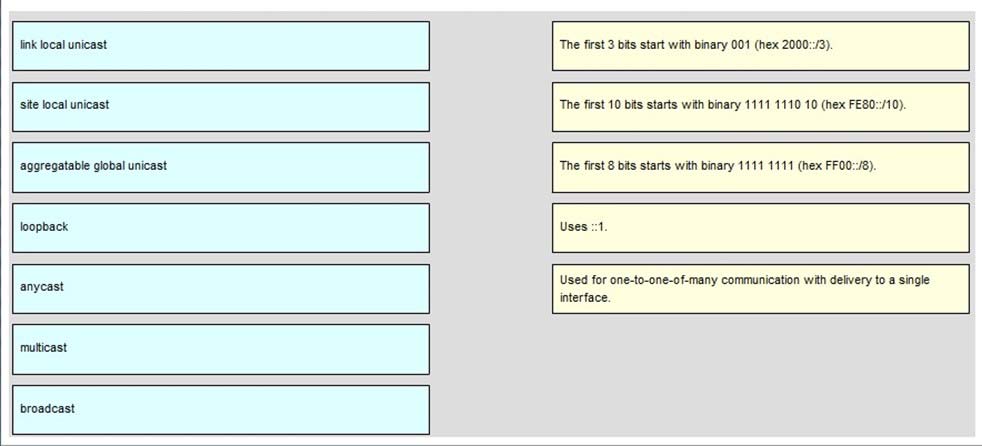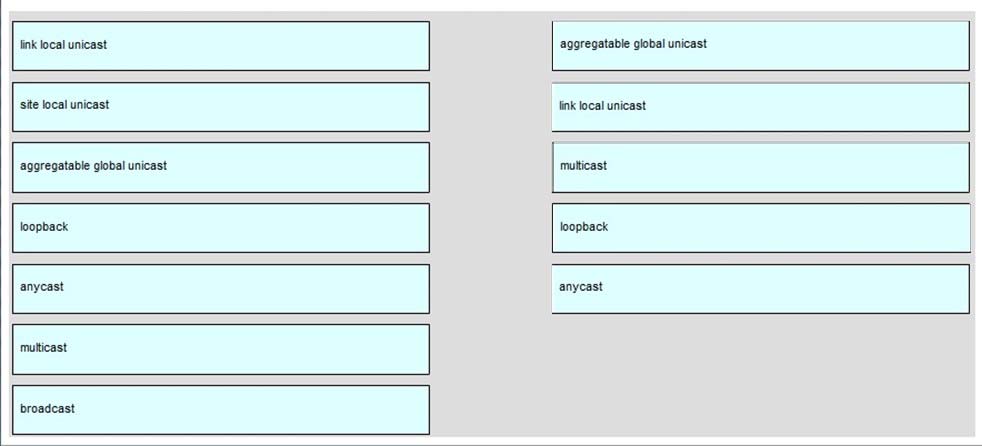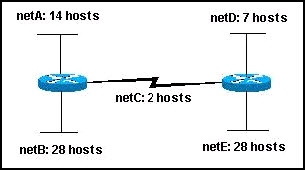Building Cisco Service Provider Next-Generation Networks, Part 1 (SPNGN1) v1.0
Question 1
Which are the two benefits of the star network topology over the bus network topology? (Choose two.)
- A. Disruption of the entire network is not required when adding new machines.
- B. Any problem which leaves the network inoperable can be traced to the central hub.
- C. This network type requires less cable as compared to linear bus topology.
- D. The performance of one of the numerous nodes cannot reflect on the performance of other nodes.
- E. The performance of the entire network is directly dependent on the performance of the hub.
Answer : AB
Question 2
DRAG DROP -
Drag the network type on the left to the correct description on the right.
Select and Place:
Answer : Explanation
Question 3
You plan to implement QoS on a network, using these four classes:
-> A class for real-time applications
-> A class for interactive applications
-> A class for batch applications
-> A scavenger class
Which two classes are interactive applications? (Choose two.)
- A. email
- B. SSH
- C. database updates
- D. IP telephony
- E. file transfers
Answer : BC
Question 4
Which statement about IPv6 global unicast addresses is true?
- A. The first 3 bits is 001.
- B. The first 4 bits is 0011.
- C. The first 4 bits is 1111.
- D. The first 16 bits is FE80 in hex.
- E. The first 16 bits is FF00 in hex.
- F. The first 16 bits is 2002 in hex.
- G. The first 16 bits is 3FFE in hex.
Answer : A
Question 5
Given the IP address 10.106.170.145 255.248.0.0, which three options are the subnet that this IP address belongs to, the host IP address range on this subnet, and the subnet broadcast IP address?
- A. subnet = 10.104.0.0/13
- B. subnet = 10.106.0.0/13
- C. subnet = 10.112.0.0/13
- D. host IP address range = 10.104.0.1 to 10.111.255.254
- E. host IP address range = 10.106.0.1 to 10.106.255.254
- F. host IP address range = 10.106.0.1 to 10.119.255.254
- G. subnet broadcast IP address = 10.106.255.255
- H. subnet broadcast IP address = 10.111.255.255
- I. subnet broadcast IP address = 10.119.255.255
Answer : ADH
Question 6
Given the IP address of 209.168.200.155/27, which two options are the subnet that this IP address belongs to and the subnet broadcast IP address? (Choose two.)
- A. 209.168.200.64 255.255.255.224
- B. 209.168.200.96 255.255.255.224
- C. 209.168.200.128 255.255.255.224
- D. 209.168.200.95
- E. 209.168.200.127
- F. 209.168.200.159
Answer : CF
Question 7
DRAG DROP -
Drag the concepts from the left and drop them on the correct descriptions on the right.
Select and Place:

Answer : 
Question 8
DRAG DROP -
Drag the IPv4 leading address bits on the left and drop them on the correct type of IPv4 addresses on the right. Not all options on the left are used.
Select and Place:

Answer : 
Question 9
DRAG DROP -
Drag the methods from the left and drop them on the best descriptions on the right.
Select and Place:

Answer : 
Question 10
Which is a valid IPv6 Link Local address?
- A. FF00::1
- B. 224.0.0.5::1
- C. FE80::1
- D. FE70::1
- E. 169.254.0.0/16
Answer : C
Question 11
What is the size difference in bits between an IPv4 address and an IPv6 address?
- A. 128
- B. 100
- C. 98
- D. 96
- E. 32
Answer : D
Question 12
DRAG DROP -
Drag the IPv6 address type from the left and drop it on the matching description on the right. Not all IPv6 address types are used.
Select and Place:

Answer : 
Question 13
Given the subnet of 209.165.201.0/27, which subnet range will make the most efficient use of the address block for connecting to customer edge devices?
- A. 209.165.201.1/32
- B. 209.165.201.1/31
- C. 209.165.201.1/30
- D. 209.165.201.1/29
- E. 209.165.201.1/24
Answer : B
Question 14
Refer to the exhibit.

Given the Class C IP network of 192.168.1.0, using VLSM, which five subnets meet the requirements in the exhibit? (Choose five.)
- A. 192.168.1.0/27
- B. 192.168.1.32/27
- C. 192.168.1.48/27
- D. 192.168.1.48/28
- E. 192.168.1.64/28
- F. 192.168.1.80/28
- G. 192.168.1.80/29
- H. 192.168.1.88/30
- I. 192.168.1.96/30
Answer : ABEFI
Question 15
Given a ring topology, which loop prevention mechanism provides the fastest reconvergence time after a link failure?
- A. Rapid Per-VLAN Spanning Tree Protocol
- B. Resilient Ethernet Protocol
- C. Multiple Spanning Tree Protocol
- D. Spanning Tree Protocol
Answer : B